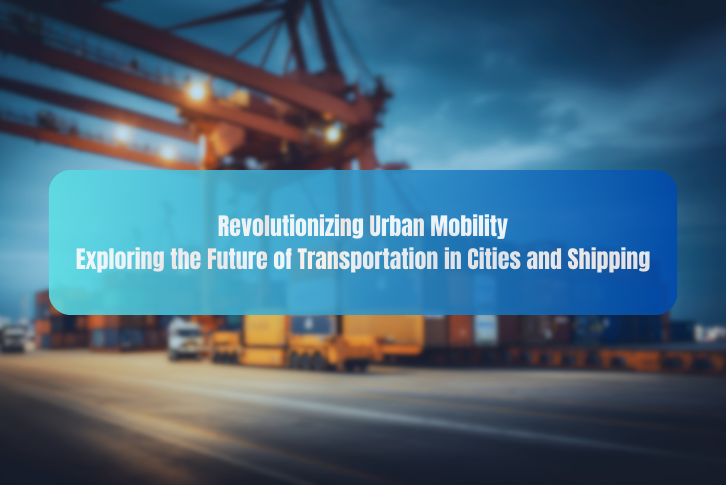Introduction:
As urban landscapes continue to evolve, the future of transportation stands at the forefront of innovation. This article delves into the transformative journey of urban mobility, examining the trends, technologies, and advancements that are reshaping how people move within cities and how goods are transported. From sustainable transit options to cutting-edge shipping solutions, the future of transportation is poised to revolutionize urban mobility.
Urban Mobility Trends:
1. Electric and Autonomous Vehicles: The rise of electric vehicles (EVs) and autonomous driving technologies is reshaping urban transportation. Electric fleets contribute to cleaner air in cities, while self-driving vehicles promise enhanced safety and efficiency in the movement of people and goods.
2. Micro-Mobility Solutions: The proliferation of micro-mobility options, such as e-scooters and bike-sharing programs, offers last-mile connectivity solutions. These alternatives reduce congestion, promote healthier lifestyles, and provide convenient options for short-distance travel within urban areas.
3. Integrated Mobility Platforms: Integrated mobility platforms are consolidating various transportation modes into a single, seamless experience. Commuters can plan, book, and pay for multi-modal journeys, incorporating buses, trains, rideshares, and more, through a unified digital interface.
Sustainable Urban Freight:
1. Cargo E-Bikes and Trikes: In urban settings, cargo e-bikes and trikes are emerging as sustainable alternatives for last-mile deliveries. These compact vehicles reduce traffic congestion, emissions, and operational costs, offering an eco-friendly solution for transporting goods in crowded city centers.
2. Smart Logistics and Route Optimization: Advanced logistics technologies, including route optimization algorithms and smart delivery systems, are streamlining shipping processes. These innovations minimize fuel consumption, enhance efficiency, and reduce the environmental impact of urban freight movements.
3. Parcel Lockers and Urban Hubs: Parcel lockers and urban hubs act as centralized points for package deliveries. These strategically located facilities enable more efficient distribution, reducing the need for individual delivery vehicles to navigate dense urban areas, thus minimizing traffic congestion.
Challenges and Solutions:
1. Infrastructure Adaptation: Adapting urban infrastructure to accommodate the evolving transportation landscape poses a challenge. However, investments in smart city initiatives, dedicated bike lanes, and charging infrastructure for electric vehicles can address these issues.
2. Regulatory Frameworks: The integration of new technologies often outpaces regulatory frameworks. Establishing clear and flexible regulations that support innovation while ensuring safety and sustainability is crucial for the continued evolution of urban mobility.
The Future Landscape:
Connected and Automated Transportation: The future envisions a connected and automated transportation ecosystem, where vehicles communicate with each other and traffic infrastructure to optimize traffic flow, enhance safety, and reduce congestion.
Drone Deliveries: Drone technology is poised to revolutionize urban shipping by offering swift and efficient deliveries. Drones can navigate congested urban environments, reaching destinations faster and with lower environmental impact.
Symbiotic Relationship:
1. Shared Infrastructure for Efficiency: The integration of urban mobility and sustainable shipping can benefit from shared infrastructure. Common facilities, such as charging stations for electric vehicles and hubs for last-mile deliveries, can streamline operations for both passenger and freight transportation.
2. Data-driven Decision Making: Leveraging data analytics and IoT devices, both urban mobility and shipping industries can make informed decisions. Real-time data on traffic patterns, delivery routes, and demand can optimize operations, reduce delays, and enhance overall efficiency.
Environmental Impact:
1. Green Initiatives in Urban Mobility: Sustainable practices in urban mobility, such as electric public transport and bike-sharing programs, contribute to reducing air pollution and carbon emissions. As cities embrace greener initiatives, the environmental impact of transportation is minimized, benefiting both residents and the planet.
2. Eco-friendly Shipping Solutions: The shipping industry is exploring eco-friendly alternatives, including the use of green fuels, electric vehicles, and even sailing vessels. Sustainable shipping practices not only align with environmental goals but also meet the increasing demand for responsible and ethical transportation.
Emerging Technologies:
1. 5G and Connectivity: The advent of 5G technology is set to revolutionize communication between vehicles, devices, and infrastructure. This high-speed connectivity enhances real-time data exchange, enabling seamless navigation, traffic management, and efficient logistics operations.
2. Blockchain in Supply Chain: Blockchain technology is transforming supply chain transparency and traceability. In shipping, blockchain can ensure the authenticity of goods, streamline documentation processes, and enhance the security of transactions, contributing to a more efficient and secure supply chain.
Human-Centric Design:
1. Accessible Transportation for All: Universal design principles in urban mobility ensure that transportation is accessible to people of all abilities. This inclusivity extends to shipping with considerations for packaging designs that accommodate diverse needs, ensuring that goods are accessible to everyone.
2. Community Engagement: Engaging with local communities is essential for the success of urban mobility and shipping initiatives. Understanding the unique needs of different neighborhoods, collaborating with residents, and incorporating community feedback are crucial steps in building transportation systems that truly serve the people they are meant for.
Global Collaboration:
1. International Standards and Regulations: Establishing international standards and regulations for both urban mobility and shipping promotes consistency and interoperability. This collaborative approach ensures a seamless experience for travelers and shippers across borders while maintaining safety and sustainability standards.
2. Cross-industry Partnerships: Collaborations between urban mobility providers and shipping companies create synergies that enhance the overall transportation ecosystem. Shared research, resources, and innovations contribute to the development of integrated solutions that address the evolving needs of both industries.
Conclusion:
As we navigate the future of transportation, the integration of urban mobility and sustainable shipping emerges as a powerful force driving positive change. By embracing innovation, prioritizing sustainability, and fostering collaboration, cities and shipping industries can collectively shape a future where transportation is not only efficient and accessible but also environmentally responsible. The synergy between urban mobility and shipping is not just about moving people and goods; it's about creating interconnected, resilient, and inclusive ecosystems that elevate the quality of life for everyone.



